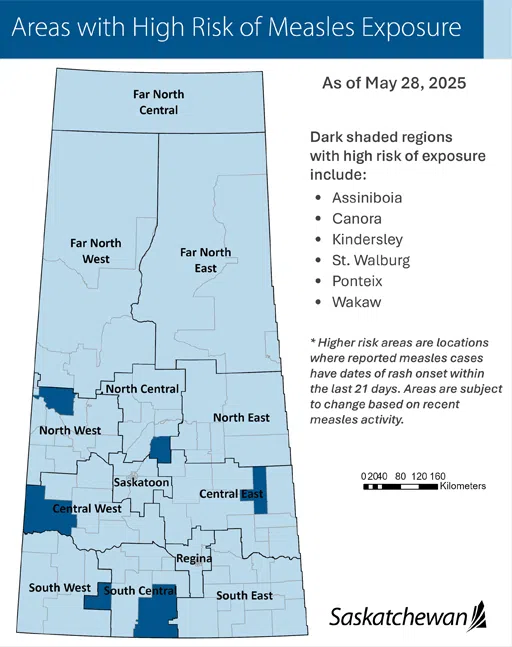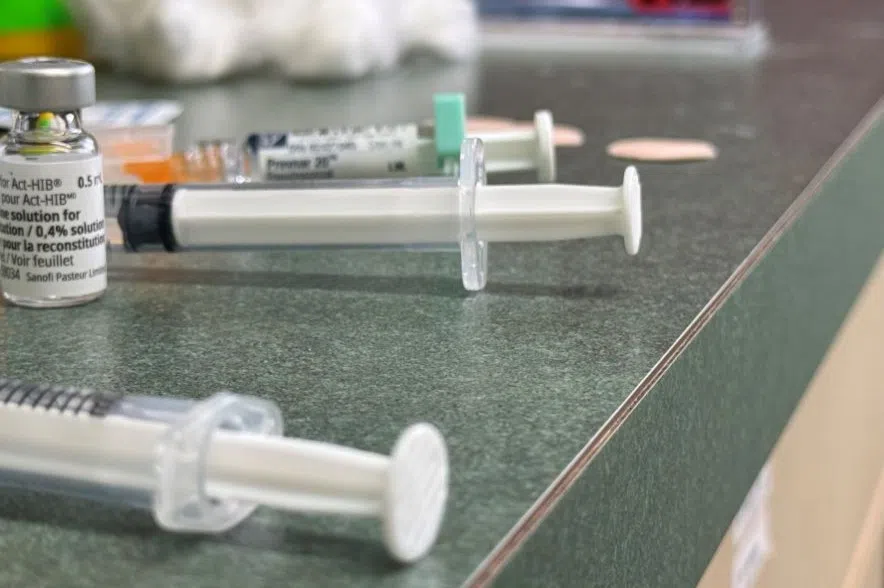Over the last several months, Saskatchewan has seen a rising number of measles cases. Children in areas with a higher chance of exposure are now eligible for the vaccine at a younger age.
The Government of Saskatchewan is making the measles vaccine available to infants six months to 11 months who “live in, are travelling to, or have contact with individuals in areas where there is a high risk of measles exposure.” — it’s similar to what infants travelling internationally already are offered.

High risk of exposure measles map from the Saskatchewan Government. (Sask. Gov./Submitted)
In a news release, Health Minister Jeremy Cockrill said, “Providing parents with the option for an additional dose of measles vaccine for infants helps to protect those who cannot protect themselves.”
Read More:
- Measles cases up to 37, with 95 per cent unvaccinated, says Sask. top doctor
- Video shows flames from aggressive Pisew Fire in La Ronge
- Regina police say Air Support Unit assisted in 75 calls in six days
- Resort Village of Candle Lake declares state of emergency
AS of May 8, 2025, Dr. Saqib Shahab said about 75 per cent of measles cases are coming from children, including a five-month-old. He also informed the public at that time the virus had been caught by a vaccinated person.
The province said, “Immunization is the single most effective way to protect against measles.”
Immunization is the single most effective way to protect against measles, said Sask. Gov.
Regina, Kindersley, Lumsden and Swift Curren have all seen cases in the last month.
“The measles vaccine has been safely used for over 50 years and is free in Saskatchewan at public health offices,” said the province.
The government said, “Routine measles vaccination is still needed at 12 and 18 months to provide lifelong protection.”
“Most children in Saskatchewan should follow the regular schedule for measles immunization; however, in outbreak situations, infants six to 11 months can be offered an earlier dose,” Shahab said.
What are the symptoms of measles?
The SHA said that the symptoms of measles include fever, cough, runny nose, red eyes, fatigue, irritability (feeling cranky or in a bad mood), small, white spots (known as Koplik spots) inside the mouth and throat, and a red blotchy rash which develops on the face and spreads down the body about three to seven days after symptoms begin and can last four to seven days.
The SHA said anyone who has any of the listed symptoms and was at any of the listed locations during the identified times should call HealthLine811, their primary care doctor or nurse practitioner.
Anyone in medical distress should go to an emergency room or call 911, and identify they may have been exposed to measles.
“The measles vaccine has been safely used for over 50 years and is free in Saskatchewan at public health offices,” said the province.
The health authority also said that measles can be prevented by the safe, effective and free measles vaccine and with two doses, the vaccination is almost 100-per-cent effective.
“Immunization is your best tool against measles, and two complete doses is what you need to have full vaccination. One dose is not enough,” the SHA’s Dr. David Torr said recently.
“Once immunized, the measles vaccine is extremely efficient, over 90 per cent of protection both against actually getting the infection and certainly against getting any complications or even death from measles.”
The second dose is especially important for people born in or after 1970.
Measles is spreading worldwide and the World Health Organization has expressed concerns.
“Get yourself up to date with the immunizations,” Torr said. “Otherwise, you’re not properly protected against measles — and it is here.”
To check your vaccination records, Torr said to check MySaskHealthRecord, and if you can’t find anything there to contact public health.
Why is measles dangerous?
Measles is highly contagious and can spread very easily by breathing contaminated air after an infected person coughs or sneezes, or by touching a contaminated surface such as a doorknob or a shopping cart.
In rare cases can lead to respiratory failure, swelling of the brain and death.
If anyone breathes the contaminated air or touches a contaminated surface and then touches their nose, eyes or mouth, they can become infected.
The virus can live up to two hours in the air or on surfaces in a space where an infected person coughed or sneezed.
It can spread to others from four days before a rash appears until four days after a rash develops. Through this period, people need to stay in strict isolation to avoid spreading the infection.
For areas of high risk of exposure, visit: saskatchewan.ca/measles
Read more:
- Measles exposure risk in Kindersley, says Saskatchewan Health Authority
- Regina, Saskatoon among latest measles exposure risk says SHA
- SHA adds Regina and Lumsden to places in Sask. with measles exposure risks
— with files from Canadian Press











